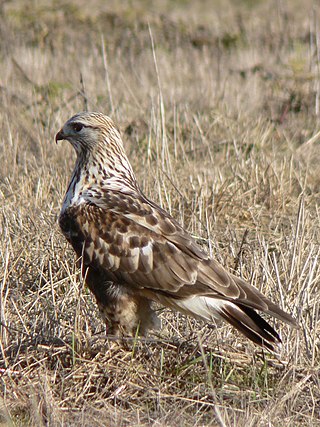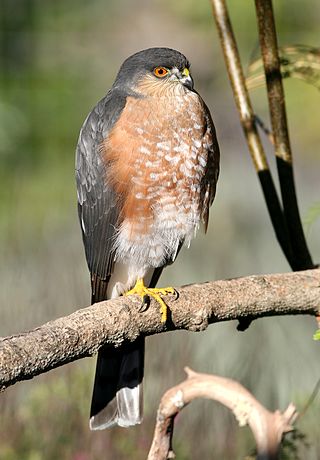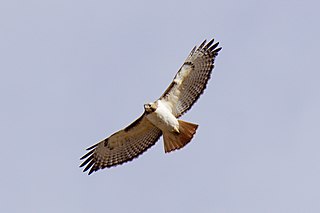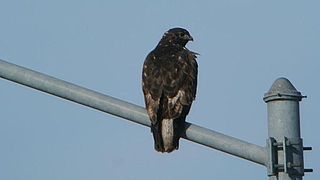
The common buzzard is a medium-to-large bird of prey which has a large range. It is a member of the genus Buteo in the family Accipitridae. The species lives in most of Europe and extends its breeding range across much of the Palearctic as far as northwestern China, far western Siberia and northwestern Mongolia. Over much of its range, it is a year-round resident. However, buzzards from the colder parts of the Northern Hemisphere as well as those that breed in the eastern part of their range typically migrate south for the northern winter, many journeying as far as South Africa.

The rough-legged buzzard (Europe) or rough-legged hawk is a medium-large bird of prey. It is found in Arctic and Subarctic regions of North America, Europe, and Russia during the breeding season and migrates south for the winter. It was traditionally also known as the rough-legged falcon in such works as John James Audubon's The Birds of America.

The sharp-shinned hawk or northern sharp-shinned hawk, commonly known as a sharpie, is a small hawk, with males being the smallest hawks in the United States and Canada, but with the species averaging larger than some Neotropical species, such as the tiny hawk. The taxonomy is far from resolved, with some authorities considering the southern taxa to represent three separate species: white-breasted hawk, plain-breasted hawk, and rufous-thighed hawk. The American Ornithological Society and some other checklists keeps all four variations conspecific.

The red-tailed hawk is a bird of prey that breeds throughout most of North America, from the interior of Alaska and northern Canada to as far south as Panama and the West Indies. It is one of the most common members within the genus of Buteo in North America or worldwide. The red-tailed hawk is one of three species colloquially known in the United States as the "chickenhawk", though it rarely preys on standard-sized chickens. The bird is sometimes also referred to as the red-tail for short, when the meaning is clear in context. Red-tailed hawks can acclimate to all the biomes within their range, occurring on the edges of non-ideal habitats such as dense forests and sandy deserts. The red-tailed hawk occupies a wide range of habitats and altitudes, including deserts, grasslands, coniferous and deciduous forests, agricultural fields, and urban areas. Its latitudinal limits fall around the tree line in the subarctic and it is absent from the high Arctic. Generally it favors varied habitats with open woodland, woodland edge and open terrain. It is legally protected in Canada, Mexico, and the United States by the Migratory Bird Treaty Act.

The broad-winged hawk is a medium-sized hawk of the genus Buteo. During the summer, some subspecies are distributed over eastern North America, as far west as British Columbia and Texas; they then migrate south to winter in the Neotropics from Mexico south to southern Brazil. Other subspecies are all-year residents on Caribbean islands. As in most raptors, females are slightly larger than males. Broad-winged hawks' wings are relatively short and broad with a tapered, somewhat pointed appearance. The two types of coloration are a dark morph with fewer white areas and a light morph that is more pale overall. Although the broad-winged hawk's numbers are relatively stable, populations are declining in some parts of its breeding range because of forest fragmentation.

The long-legged buzzard is a bird of prey found widely in several parts of Eurasia and in North Africa. This species ranges from Southeastern Europe down to East Africa to the northern part of the Indian subcontinent. The long-legged buzzard is a member of the genus Buteo, being one of the larger species therein. This species is simultaneously considered relatively powerful and aggressive for its taxonomic group as well as a relatively sluggish raptor overall. Like most buzzards, it prefers small mammals such as rodents, including gerbils, ground squirrels, voles and rats, also taking reptiles, birds and insects as well as carrion. Adaptable to a variety of habitats, long-legged buzzards may nest on a variety of surfaces, including rocks, cliffs and trees. it is a typical buzzard in its reproductive biology. The long-legged buzzard is widely distributed and appears to be quite stable in population. Therefore, it is considered as Least Concern by the IUCN.

The tawny eagle is a large bird of prey. Like all eagles, it belongs to the family Accipitridae. Its heavily feathered legs mark it as a member of the subfamily Aquilinae, also known as booted eagles. Tawny eagles have an extensive but discontinuous breeding range that constitutes much of the African continent as well as the Indian subcontinent, with rare residency in the southern Middle East. Throughout its range, it favours open dry habitats such as semideserts, deserts steppes, or savanna plains. Despite its preference for arid areas, the species seldom occurs in areas where trees are entirely absent. It is a resident breeder which lays one to three eggs in a stick nest most commonly in the crown of a tree. The tawny eagle is perhaps the most highly opportunistic of all Aquilinae, and often scavenges on carrion or engages in kleptoparasitism towards other carnivorous animals but is also a bold and active predator, often of relatively large and diverse prey. It is estimated that tawny eagles can reach the age of 16 years old. Nonetheless, precipitous declines have been detected throughout the tawny eagle's range. Numerous factors, particularly loss of nesting habitat due to logging and global warming, as well as persecution and other anthropogenic mortality are driving the once numerous tawny eagle perhaps to the brink of extinction.

The augur buzzard is a fairly large African bird of prey. This species is distinct in typical adult plumage for its blackish back, whitish underside and orange-red tail, while juvenile augur buzzards are generally rather brown in colour; however a dark morph is known, which causes the bird's entire body to become darker. This member of the Buteo genus is distributed in several parts of the central and southern Africa, normally being found from Ethiopia to southern Angola and central Namibia. It is resident and non-migratory throughout its range. This is a species of mountains, and adjacent savannah and grassland. This is a typical buteonine raptor, being a generalist predator which tends to prefer small mammals supplemented by reptiles and birds among various prey items.

The eastern red-tailed hawk is a subspecies of the red-tailed hawk that breeds from southeast Canada and Maine south through Texas and east to northern Florida.

The southwestern red-tailed hawk is a subspecies of red-tailed hawk that breeds from northern Chihuahua to southern Texas. It winters in Arizona, New Mexico and southern Louisiana. This seems to be a particularly large subspecies, although its size is not drastically different from the western red-tailed hawk, and, going on average wing size and tarsal length, this appears to be the largest race of red-tailed hawk. The wing chord of males can range from 385 to 402 mm, averaging 393.3 mm (15.48 in), and, in females, it ranges from 425 to 436 mm, averaging 430.7 mm (16.96 in). Additionally, males and females average 210.9 and 223.8 mm in tail length, 88 and 93 mm in tarsal length and 26.3 and 27.5 mm in culmen length. Hybridization seems to occur in eastern Texas with the eastern red-tailed hawk, broadly to the west with B. j. calurus and, possibly, in Nuevo León and Chihuahua with the Mexican Highlands red-tailed hawk. This race combines the darker back of B. j. calurus with the paler underside of B. j. borealis, with the belly band either entirely absent or only manifesting in light streaking. The tail is variable but relatively pale, with some individuals showing almost no dark subterminal band, others having quite a broad subterminal band and some showing extensively barring on top like darker morphs of B. j. calurus.

Harlan's hawk or Harlan's red-tailed hawk is a subspecies of the red-tailed hawk.

Krider's hawk or Krider's red-tailed hawk is a subspecies or color morph of red-tailed hawk. Authorities vary in their treatment of the taxon. It was named after John Krider, the gunsmith from Philadelphia who collected the type specimen, which is preserved in the collection of the Academy of Natural Sciences of Drexel University.

The Jamaican red-tailed hawk is the nominate subspecies of the red-tailed hawk, a bird of prey of North America. The subspecies B. j. jamaicensis occurs in the northern West Indies, including Jamaica, Hispaniola, Puerto Rico and the Lesser Antilles, but not the Bahamas or Cuba, where it is replaced by the Cuban red-tailed hawk. El Yunque National Forest, Puerto Rico, holds some of the highest known density of Jamaican red-tailed hawks. The bird is referred to as a guaraguao in the Dominican Republic and Puerto Rico.

The Alaska red-tailed hawk is a subspecies of red-tailed hawk that breeds from southeastern coastal Alaska to the Queen Charlotte Islands and Vancouver Island in British Columbia. Despite its northerly distribution, this is the second smallest of the red-tailed hawks. Only the Jamaican red-tailed hawk is smaller.

The Central American red-tailed hawk is a subspecies of red-tailed hawk resident from Nicaragua to Panama. This subspecies is relatively small. The wing chord of males can range from 368 to 391 mm, averaging 372.7 mm (14.67 in), and, in females, it ranges from 393 to 427 mm, averaging 401.9 mm (15.82 in). Additionally, males and females average 213.2 and 230 mm in tail length, 88.6 and 86.9 mm in tarsal length and 26 and 26.7 mm in culmen length. This race may average around 900 g (2.0 lb). This subspecies is arguably the most handsomely colored in typical adult plumage. This subspecies is dark brown above and heavily pigmented dorsally, the white of the breast contrasting with a deep rufous abdominal band which contains black streaks and spots. Meanwhile, the flanks, wing linings and sides are an unbarred deep rufous. In some birds, the rich rufous color continues to the underside. The chest is much less heavily streaked than in northern migrants western red-tailed hawk to Central America. Unlike other Central American races of red-tailed hawk, there seems to be no dark morph in this subspecies.
The Tres Marias red-tailed hawk is a relatively small subspecies of red-tailed hawk endemic to Islas Marías, an island some 100 km (62 mi) off the coast of Mexico. Unlike some other island races, the validity of this race has rarely been called into question. The wing chord of males can range from 368 to 370 mm, averaging 369.3 mm (14.54 in), and, in females, it ranges from 395 to 400 mm, averaging 397.4 mm (15.65 in). Males and females average 228.9 and 235.5 mm in tail length, 85.9 and 88.3 mm in tarsal length and 27.4 and 29.2 mm in culmen length. This race is similar to the western red-tailed hawk but, beyond being noticeably smaller, is duskier and duller hued overall and has a more cinnamon wash below, with heavily dark barred thighs.
The Mexican Highlands red-tailed hawk is a subspecies of red-tailed hawk endemic to the Mexican Highlands. Not all authorities recognize this race, however, in recent years, most list it as valid. Like other Neotropical races, this one is relatively small. wing chord averages 378.9 mm (14.92 in) in males and 401.1 mm (15.79 in) in females. Males and females average 215 and 230.4 mm in tail length, 89.1 and 88 mm in tarsal length and 26.3 and 26.8 mm in culmen length. Apparently, this race is similar to B. j. kemsiesi to the south but unlike that race it has rufous barring that extends to the flanks and belly. Apparently, some dark morphs have occurred. One other unique feature is its massive feet, with a toe length nearly 10% longer than the western red-tailed hawk despite its otherwise small body size. The evolutionary reason for these relatively large feet is unknown.
The red-tailed hawk kemsiesi is a dark subspecies of red-tailed hawk resident from Chiapas, Mexico, to Nicaragua. The wing chord of males can range from 357 to 382 mm, averaging 376 mm (14.8 in), and, in females, it ranges from 362 to 402 mm, averaging 398.2 mm (15.68 in). Males and females average 212.5 and 231 mm in tail length, 87.8 and 87.1 mm in tarsal length and 26.1 and 26.4 mm in culmen length. This race is similar to the southwestern red-tailed hawk but markedly smaller, with its thighs barred with rufous. The dark wing marking may not be distinct in paler birds. A dark morph, similar to the western red-tailed hawk, is known to occur in this race.
The Socorro red-tailed hawk is a subspecies of red-tailed hawk endemic to Socorro Island, 600 kilometres (370 mi) off the west coast of Mexico. The wing chord of males can range from 368 to 385 mm, averaging 378.4 mm (14.90 in), and, in females, it ranges from 385 to 415 mm, averaging 412.8 mm (16.25 in). Males and females average 214.1 and 230.4 mm in tail length, 84.9 and 89.1 mm in tarsal length and 24.9 and 28.6 mm in culmen length. One female was found to have weighed 1,260 g (2.78 lb). This race, which is physically fairly similar to the western red-tailed hawk, is not recognized by some authorities because it has a breeding population of perhaps fewer than 20 birds. There are some differences from B. j. calurus, such as their larger, more robust feet and much greater sexual dimorphism, which is the most pronounced of any race linearly, averaging 10.42% when all standard measurements are considered. Furthermore, Socorro hawks tend to average more melantic in overall color, being a duller, darker brown than mainland birds.

The Florida red-tailed hawk is a subspecies of red-tailed hawk. It occurs year-round in peninsular Florida north as far as Tampa Bay and the Kissimmee Prairie and south down to the Florida Keys. This subspecies is very large, only the southwestern red-tailed hawk averages larger in overall dimensions. Although a non-migratory subspecies, its wings are notably longer than those of the eastern red-tailed hawk and S. b. umbrinus may be conspicuously larger than the relatively small southern S. b. borealis that they overlap with. The wing chord of males can range from 396 to 400 mm, averaging 398.8 mm (15.70 in), and, in females, it ranges from 373 to 432 mm, averaging 408.9 mm (16.10 in). Males and females average 225 and 234 mm in tail length, 91.1 and 88.9 mm in tarsal length and 27.2 and 30 mm in culmen length. Compared to B. j. borealis which it replaces, it has a darker back, more similar to the dark brown of the western red-tailed hawk. Adults tend to have chestnut to rufous side patches, multiple tail bars and no barring on the "trousers". A very rare dark morph has been reported.
















